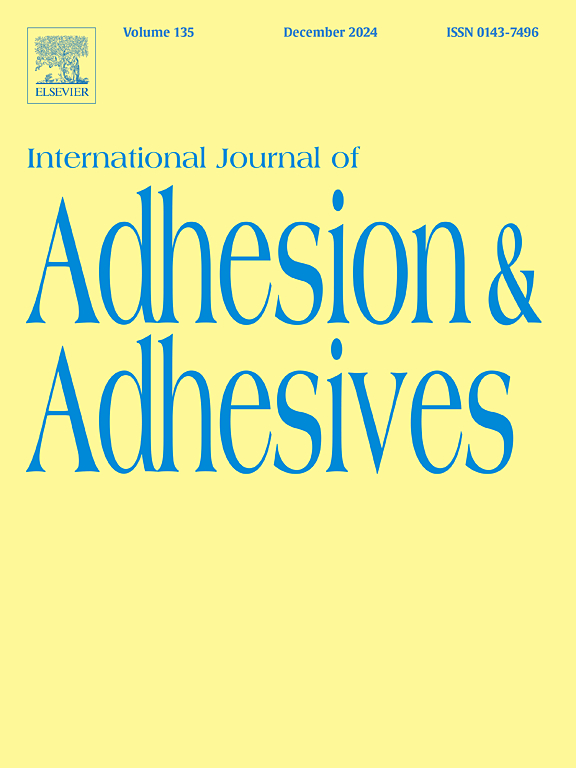The interaction of focused ultrasound and dentin: Thermal, structural and chemo-mechanical characterization
IF 3.5
3区 材料科学
Q2 ENGINEERING, CHEMICAL
International Journal of Adhesion and Adhesives
Pub Date : 2025-04-14
DOI:10.1016/j.ijadhadh.2025.104033
引用次数: 0
Abstract
Objective
This laboratory study aimed to develop an ex vivo model simulating pulpal micro-circulation to characterize temperature variations within the pulpal space following high intensity focused ultrasound (HIFU) exposure. In addition, to assess the interaction and effect of HIFU exposure parameters on human dental pulp stem cells (hDPSCs) response and the variations in dentin surface microstructure and chemo-mechanical characteristics.
Methods
Thermal camera mapping and intra-pulpal temperature measurements with thermocouples were conducted (continuous measurement of 60 s) at HIFU intensities of 20 and 25 W with varying active-duty ratios. hDPSCs tolerance and viability were assessed via acid-phosphatase assay and live/dead fluorescence imaging. Subsequently the effect of HIFU exposure on the structure, chemical composition and nano-mechanical properties of dentin was characterised by scanning electron microscopy, atomic force microscopy, transmission electron microscopy, Raman spectroscopy and nano-indentation testing.
Results
Thermal analyses revealed two potentially thermally favourable HIFU exposure parameters: 20 W and 25 W at active-duty ratio of 1/6 ms. The two identified HIFU parameters were further investigated at 30 and 60 s treatment time on dentin surface. HIFU treatment did not result in statistically detrimental effects on the viability of hDPSCs (p > 0.05). HIFU treatment for 60 s effectively removed the overlying smear layer exposing dentin-tubules orifices and partial revealed collagen fibril's structure. No significant change in roughness or chemical composition (960/1450 cm−1 mineral/organic ratio) was detected after HIFU treatment (p > 0.05). However, HIFU treatment at 25 W for 60 s resulted in a significant decrease (p < 0.05) in surface hardness compared to sound dentin.
Significance
HIFU treatment at 25 W for 60 s demonstrates effective removal of the dentin smear layer and partial exposure of dentin collagen fibrils without significantly altering the dentin chemical composition without adversely affecting the underlying hDPSCs.
聚焦超声与牙本质的相互作用:热、结构和化学力学表征
目的建立模拟牙髓微循环的离体模型,以表征高强度聚焦超声(HIFU)照射后牙髓间隙内的温度变化。此外,评估HIFU暴露参数对人牙髓干细胞(hDPSCs)反应的相互作用和影响,以及牙本质表面微观结构和化学力学特征的变化。方法采用热像仪测温和热电偶测量牙髓内温度(连续测量60 s),测量强度分别为20和25 W。通过酸性磷酸酶测定和活/死荧光成像评估hDPSCs的耐受性和活力。随后采用扫描电镜、原子力显微镜、透射电镜、拉曼光谱和纳米压痕测试表征HIFU暴露对牙本质结构、化学成分和纳米力学性能的影响。结果热分析显示了两个潜在的热有利的HIFU暴露参数:20 W和25 W,工作比为1/6 ms。在牙本质表面处理时间30s和60s时,进一步研究了两个确定的HIFU参数。HIFU治疗对hdpsc的生存能力没有统计学上的不利影响(p >;0.05)。HIFU治疗60 s有效地去除覆盖的涂片层,暴露牙本质小管孔,部分显示胶原纤维结构。HIFU处理后,未检测到粗糙度或化学成分(960/1450 cm−1矿物/有机比)的显著变化(p >;0.05)。然而,在25 W下HIFU治疗60 s可显著降低(p <;与正常牙本质相比,牙本质的表面硬度为0.05)。在25 W下持续60 s的hifu治疗可以有效去除牙本质涂抹层和部分暴露牙本质胶原原纤维,而不会显著改变牙本质的化学成分,也不会对底层的hdpsc产生不利影响。
本文章由计算机程序翻译,如有差异,请以英文原文为准。
求助全文
约1分钟内获得全文
求助全文
来源期刊

International Journal of Adhesion and Adhesives
工程技术-材料科学:综合
CiteScore
6.90
自引率
8.80%
发文量
200
审稿时长
8.3 months
期刊介绍:
The International Journal of Adhesion and Adhesives draws together the many aspects of the science and technology of adhesive materials, from fundamental research and development work to industrial applications. Subject areas covered include: interfacial interactions, surface chemistry, methods of testing, accumulation of test data on physical and mechanical properties, environmental effects, new adhesive materials, sealants, design of bonded joints, and manufacturing technology.
 求助内容:
求助内容: 应助结果提醒方式:
应助结果提醒方式:


